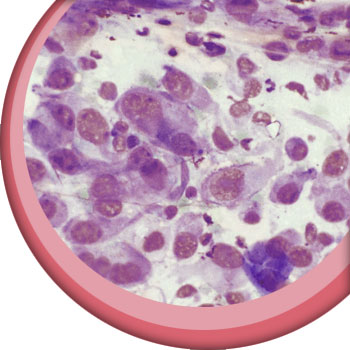Gram-negative bacilli
Knowledge of the bacterial species present when dealing with an infectious condition will be very helpful in selecting an appropriate antimicrobial and therefore culture and sensitivity testing is often indicated. If this information is not available, a combination of cytology and a knowledge of which pathogens are likely for a given situation may help in selecting an appropriate antimicrobial. Cytology will allow classification of the bacteria present by Gram-staining and morphology, which will narrow down the possible species. Knowledge of the site of infection may suggest whether bacteria are likely to be aerobic or anaerobic, for example cases of pyothorax and abscesses are likely to involve obligate and facultative anaerobes.3
Type of organism
Gram-negative
Possible bacterial pathogens4
Bacilli:
Escherichia coli (facultative anaerobe)
Enterobacter spp. (facultative anaerobe)
Klebsiella spp. (facultative anaerobe)
Salmonella spp. (facultative anaerobe)
Proteus mirabilis (facultative anaerobe)
Bordetella bronchiseptica (coccobacilli)
Pasteurella multocida (stain as coccobacilli with Giemsa)
Pseudomonas aeruginosa
Brucella spp. (intracellular)
Campylobacter spp. (can be spirals, most are microaerophilic but some prefer anaerobic conditions)
Rickettsia spp. (intracellular)
Useful antimicrobials5,6
Amoxicillin and ampicillin but not for those that produce beta-lactamase. Certain Gram-negatives are often resistant e.g. Klebsiella spp. and Pseudomonas spp.
Amoxicillin-clavulanic acid but certain Gram-negatives are often resistant
Cephalexin but Pseudomonas spp. are usually resistant
Erythromycin but Enterobacteriaceae are usually resistant
Tetracyclines
Fluoroquinolones*
Gentamicin but not for anaerobes
Trimethoprim/Sulphonamide
Key: Aerobic Anaerobic
*Most veterinary fluoroquinolones are not effective against anaerobes.

Disclaimer: Indications and doses may vary between products. The antimicrobials listed may constitute an off licence use of the product and as such should only be used according to the ‘Cascade’, further details of which are available on the RCVS, VMD and NOAH websites. Veterinary surgeons are advised to carefully check the Summary of Product Characteristics (SPC) before prescribing a product and obtain informed owner consent where required.

